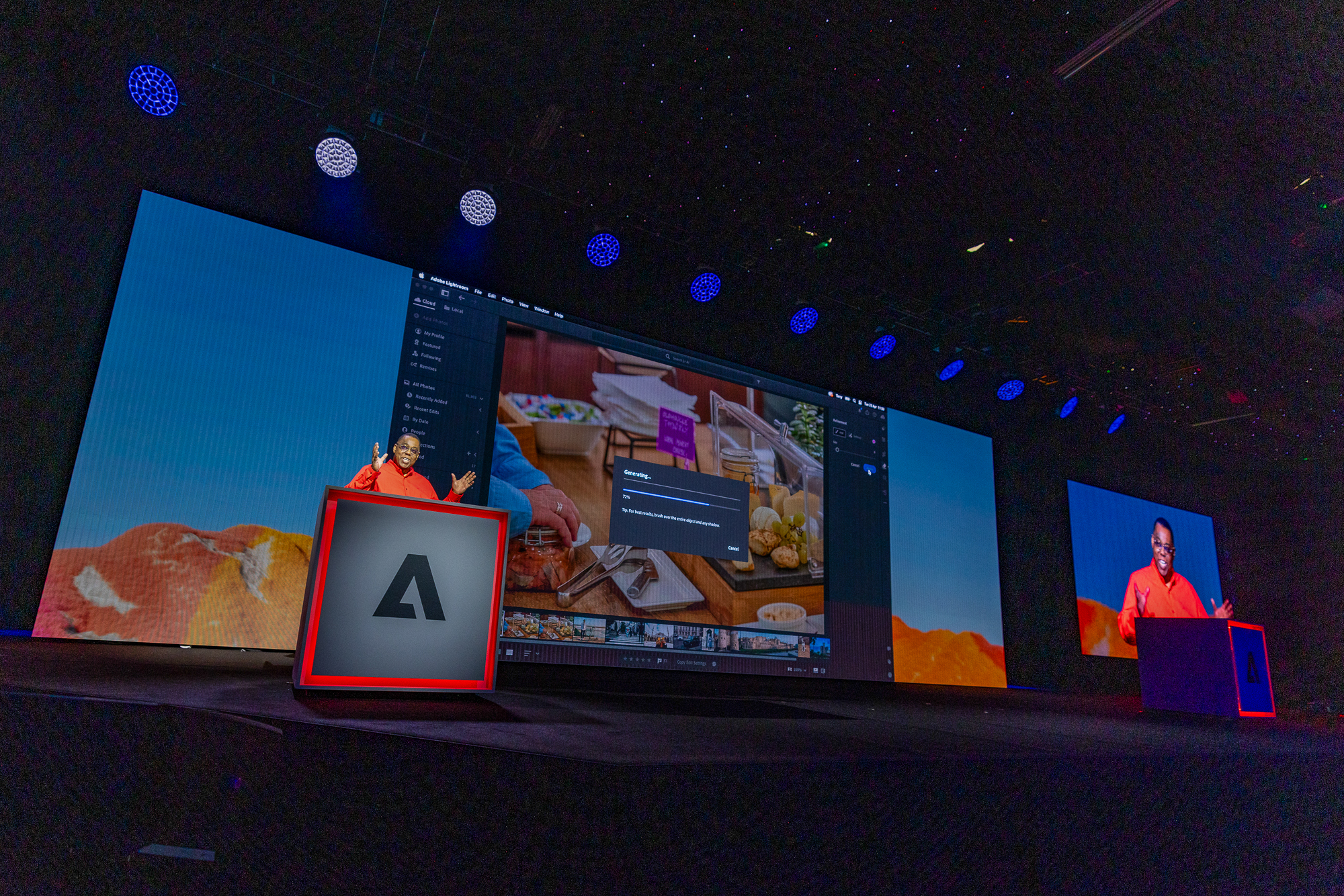I’m happy to share the news about today’s Adobe Photography Release (May 2024). There are updates across the Lightroom Ecosystem, including Lightroom, Lightroom Classic, Lightroom on Mobile, and Lightroom on Web.
Today, we are introducing a groundbreaking feature in Lightroom-Generative Remove, powered by Firefly. This innovative tool allows you to effortlessly eliminate distractions from your photos with a single brush stroke, all without the need to switch to Photoshop.
We’ve also improved Lens Blur (which was in Early Access), making it easier than ever to control the depth of field in your photos with professional results.
Easily remove distractions with Generative Remove (early access)
Available on Lightroom, Lightroom Classic, Lightroom for mobile (iOS & Android), Lightroom for web, and Adobe Camera Raw

With Generative Remove, powered by Firefly, you can easily remove unwanted objects and distractions, even on complex backgrounds, in just a few simple steps.
Distractions can ruin an otherwise great photo. Generative Remove allows you to quickly remove them with realistic, high-quality results.
Generative Remove uses Firefly technology to intelligently fill the photo behind removed items. The results on complex backgrounds are particularly impressive, like matching a detailed wallpaper pattern or the fabric on a plaid shirt. Lightroom will even give you a few variations to choose from so you’ll have full creative control in picking the one you like best.
*Note that the previous “Heal” tool is now called “Remove.” You’ll find Generative Remove within the Remove tool, accessible via a toggle on Lightroom mobile or a check box on Lightroom for web, Lightroom Classic, and Lightroom.
Generative Remove is powered by Firefly Image 1 Model and is available today as an early access feature to Lightroom paid plan subscribers across the Lightroom ecosystem via mobile, desktop, iPad, web and Classic.
Get a pro-quality background blur with AI-powered Lens Blur
Available on Lightroom, Lightroom Classic, Lightroom for mobile (iOS & Android), Lightroom for web, and Adobe Camera Raw
Our improved Lens Blur uses the power of AI to map the foreground and background of your image to apply a pro-quality blur effect. Blur busy backgrounds to make your portraits pop, add a dramatic blur to nature photos to make the greenery stand out, or get a dreamy, blurred background from a sparkling city skyline at night.
With the interactive and flexible controls of Lens Blur, you can play around with the blur amount, change the shape of the light points or “bokeh,” and customize the area you want to blur using the focus range tool.
This new release of Lens Blur includes better subject detection, the ability to create custom presets, and batch editing capabilities. Please note that the latter two features are coming soon to Android devices.
Get the perfect blur effect in a click with new Lens Blur Adaptive Presets
Available on Lightroom, Lightroom Classic, Lightroom for mobile (iOS & Android), Lightroom for web, and Adobe Camera Raw

Today, we also introduce a set of brand-new adaptive presets for Lens Blur that use AI technology to apply a blur effect that’s tailor-made to your photo. Presets are great for quickly finding the perfect blur look without having to dig into fine-tuned edits.
You can choose from seven Blur Background adaptive presets that change the shape and style of the blur in the background: Subtle, Strong, Circle, Bubble, Geometric, Ring, or Swirl.
After you pick a preset, you can adjust the strength of the blur with the amount slider or customize the effect further by using the Lens Blur tool controls.
What else is new in the latest Lightroom release
We’ve also made several updates across the Lightroom ecosystem that give you more creative control and flexibility when working on your photos and videos.
Enjoy Sony tethering support
Available in Lightroom Classic on the latest Sony digital cameras such as the Alpha 7 IV and Alpha 7R V – for a full list see here.
See your images on a big screen as soon as you click the camera shutter. We’re expanding support for tethering by adding the latest Sony digital cameras so you can photograph directly into Lightroom Classic, saving precious time on your workflow. It’s now even easier to review photo details, edit in real-time, and collaborate with on-set production teams and clients.
For a full list of all newly supported cameras in Lightroom see this page.
Easily move cloud files to your local drive
Available on Lightroom
At last year’s Adobe MAX conference, we introduced local storage for Lightroom — the option to work with your photos and videos in Lightroom without having to import or sync them to the cloud.
With this release, it’s now easier to move or archive your photos off the Lightroom Cloud and store them on your computer’s internal drive, an external drive, or a local server. This is great when you want to free up space on the cloud, or for file management such as archiving past projects to a local drive.
You can select multiple files within an album, or an entire album to move to your local drive. Lightroom will ask what folder structure you’d like to use, so you can preserve the album structure locally as you move it off the cloud. This is especially useful if you have a high volume of photos and are working with numerous files at a time.
Edit videos with the Tone Curve
Available on Lightroom
You can now edit videos in Lightroom using Tone Curve. This graph-based tool enables you to fine-tune a video’s brightness and contrast by simply dragging the curve control points up or down. For example, if a point on the tone curve is moved up, it becomes a lighter tone; if it is moved down, it becomes darker.
Create and play slideshows in Lightroom
Available on Lightroom
Lightroom now has a slideshow feature so you can display selected photos from your library in a slideshow format — a great way to share edits with clients, family, or friends.
Performance, reliability, and workflow enhancements to Lightroom Classic
We’ve also made the following improvements to Lightroom Classic, so that it performs smoothly and enables you to work more efficiently:
- Improved cloud syncing: Images in your Lightroom Cloud will now more reliably match what you see in your Classic catalog and vice versa
- Smoother image navigation in Develop: We’ve improved the responsiveness and navigation experience in Develop along with better caching
- Optimized preview management: We have re-architected the way we generate and store previews, resulting in a much smoother experience
- Filter by exported images: You can now filter for files by their export status and create a smart collection showing what’s been exported
- Search support for new metadata: We’ve introduced new capabilities to search and create smart collections by alt text, extended descriptions, and images edited with Remove or Point Color
Watch a Demo
I created a video showing off these features that you can watch here:
Try out the new features from today.
You can download the latest features and enhancements today on Lightroom for mobile from the Apple App Store, Google Play Store, and Samsung Galaxy Store. Try the Lightroom app for free by going to the app store on your mobile phone.
Lightroom for web features are available at lightroom.adobe.com and no download is required. Lightroom for desktop can be downloaded via the Creative Cloud Desktop app. To learn more about these updates, check out the What’s New pages for Lightroom and Lightroom Classic.
Disclaimer: Generative Remove in Lightroom is available to all Creative Cloud members with a subscription or trial that includes Lightroom. Generative Remove is not available in China.
Our commitment to AI ethics and principles
Adobe is committed to developing AI in accordance with the company’s AI Ethics principles of accountability, responsibility, and transparency. As AI becomes more prevalent in content creation, Adobe believes that it is important to provide consumers with transparency about its use in the creative process. A recent study from Adobe showed that 76% of U.S. consumers emphasized the importance of knowing if online content is generated using AI. When Generative Remove becomes generally available, Content Credentials will be automatically attached to photos edited with the feature in Lightroom. Like a “nutrition label” for digital content, Content Credentials are tamper-evident metadata that can provide important information about how content was created, modified, and published.
Content Credentials are built on the C2PA open standard and supported by the Adobe-led Content Authenticity Initiative (CAI), which was founded in 2019 to increase trust in the digital ecosystem. Today, the CAI has grown into a global coalition of over 3,000 members across tech, policy, media companies, creative professionals, researchers and more, all working together to add transparency to digital content.
